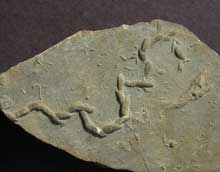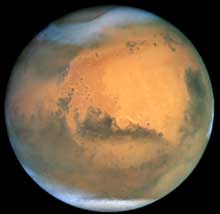Earth Sciences (also referred to as Geosciences), which deals with basic issues surrounding our planet, plays a vital role in the area of energy and raw materials supply.
Earth Sciences comprises subjects such as geology, geography, geological informatics, paleontology, mineralogy, petrography, crystallography, geophysics, geodesy, glaciology, cartography, photogrammetry, meteorology and seismology, early-warning systems, earthquake research and polar research.

Study suggests macroscopic bilaterian animals did not appear until 555 million years ago
The traces left behind by ancient animals may hold the key to determining when macroscopic bilaterians — animals that are symmetric about a central axis, with a body divided into equivalent right and left halves, and with an anterior-posterior polarity (e.g., this includes worms, ants, and ranging up to humans) — first appeared. A team led by Dr. Mary Droser, professor of geology at the Univers

If you think that summers are getting hotter, you could be right — depending on where you live. Summers are heating up if you live in or near any major U.S. city. But in rural areas, temperatures have remained relatively constant.
“What surprised me was the difference in the extreme temperature trends between rural and urban areas,” says Arthur T. DeGaetano, Cornell associate professor of earth and atmospheric sciences, who reviewed temperature trends from climate-reporting stations across

One of the known facts about landfalling hurricanes is their rapid decay, yet some of them retain tropical storm winds and gusts well inland. While studies have shown that the reduction in surface evaporation is a reason for hurricane decay during landfall, little is known about the effect of land surface water on the intensity of hurricanes.
In a recent issue of the Journal of Atmospheric Sciences, URI Graduate School of Oceanography (GSO) physical oceanographer Isaac Ginis, Weixing Shen, f

Orbit affects climate on Mars similar to the way it affects climate on Earth, say three scientists, who used a model of climate change on Earth to explain the layers of deposits in the polar regions of the Red Planet.
Their study appears in the Sept. 26 issue of Nature, and suggests that a climate change theory for Earth can also be applied to Mars and possibly to other Earth-like planets.
“The orbital theory of climate change has been successful in explaining changes in the Earth&

Based on satellite data from the European Space Agency, the national meteorological centre of the Netherlands predicts the Antarctic ozone hole will break apart this week, months earlier than usual.
A scientist at the Royal Netherlands Meteorological Institute (KNMI) adds that the depth of the ozone hole is much smaller than previously seen.
“This breakdown is occurring exceptionally early in the year, about two months earlier than normal”, says Henk Eskes, a KNMI senior scientist.

Active mountain ranges like the Olympic Mountains, Taiwan Central Range or the Southern Alps are still growing, but they are not getting any taller. River cutting and erosion keep the heights and widths of uplifted mountain ranges in a steady state according to an international team of geoscientists.
“These mountains grew to 2.5 to 3 miles high over the past few million years and then they stopped increasing,” says Dr. Rudy L. Slingerland, professor of geology and head of Penn State’s g